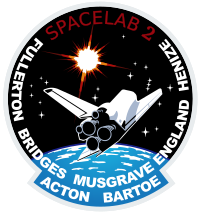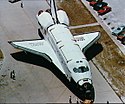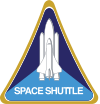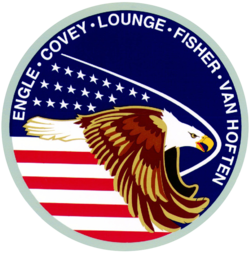STS-51-F
| Missionsemblem | |||||
|---|---|---|---|---|---|
 | |||||
| Missionsstatistik | |||||
| Missionsnavn: | STS-51-F | ||||
| Rumagentur: | NASA | ||||
| Rumfærge: | Challenger (8) | ||||
| Antal besætningsmedlemmer: | 7 | ||||
| Affyringsrampe: | 39A (KSC) | ||||
| Opsendelse: | 29 juli 1985 | ||||
| Landing: | 6 august 1985 | ||||
| Landet på: | Edwards Air Force Base | ||||
| Varighed: | 7 døgn 22 timer | ||||
| Foto af besætningen | |||||
 | |||||
| Navigation | |||||
| |||||
STS-51-F (Space Transportation System-51-F) var Challengers 8. rumfærge-flyvning, opsendt d. 29. juli 1985 og vendte tilbage d. 6 august 1985.
Missionen medbragte rum-laboratoriet Spacelab-2 med eksperimenter.
Fem minutter efter opsendelsen svigtede den ene af rumfærgens tre hovedmotorer, hvilket medførte en såkaldt Abort to orbit, og rumfærgen måtte gå i et lavere kredsløb end planlagt.
Besætning

 Gordon Fullerton (kaptajn)
Gordon Fullerton (kaptajn)
 Roy Bridges (pilot)
Roy Bridges (pilot)
 Story Musgrave (missionsspecialist)
Story Musgrave (missionsspecialist)
 Anthony Englan (missionsspecialist)
Anthony Englan (missionsspecialist)
 Karl Henize (missionsspecialist)
Karl Henize (missionsspecialist)
 Loren Acton
Loren Acton
 John-David Bartoe
John-David Bartoe
Missionen
Hovedartikler:
| Wikimedia Commons har medier relateret til: |
Eksterne henvisninger
- STS-51-F NASA (engelsk)
| ||||||||
| ||||||||||||||||||||
Medier brugt på denne side
Shuttle mission 51-G patch
- The STS-51G insignia illustrates the advances in aviation technology in the United States within a relatively short span of the twentieth century. The surnames of the crewmembers for the Discovery's mission appear near the center edge of the circular design.
SVG version of PNG Space Shuttle Logo/Patch.
Challenger's roll-out from the orbiter processing facility (OPF) to the vehicle assembly building (VAB) is underway as preparations continue towards launch of STS-8. Challenger is being towed into the VAB by tractor, with parked cars on all sides. Close-up view of the Challenger as it is towed in to the VAB. The Kennedy Space Center alternative photo number is 108-KSC-83PC-533 (39145).
View of the Spacelab 2 pallet in the open payload bay. The solar telescope on the Instrument Pointing System (IPS) is fully deployed. The Solar UV high resolution Telescope and Spectrograph are also visible.
Forfatter/Opretter: Rei-artur (diskussion · bidrag), reshaped by F l a n k e r (talk), Licens: CC-BY-SA-3.0
symbol of Mars. 400 × 400 pixels nominal dimensions, line 45 pixel tick, circle 295 × 295 pixel, not joined with arrow. Colour: red=0 green=0 blue=140.
![]() Vektorgrafikken blev lavet med Inkscape.
Vektorgrafikken blev lavet med Inkscape.
The crew assigned to the STS-51F mission included (kneeling left to right) Gordon Fullerton, commander; and Roy D. Bridges, pilot. Standing, left to right, are mission specialists Anthony W. England, Karl G. Henize, and F. Story Musgrave; and payload specialists Loren W. Acton, and John-David F. Bartoe. Launched aboard the Space Shuttle Challenger on July 29, 1985 at 5:00:00 pm (EDT), the STS-51F mission's primary payload was the Spacelab-2.
Close-up view of a portion of the F6 forward flight station panel. Photo focuses on the sub-panel controlling the shuttle ascent abort mode, RCS firing command indicators and the Range Safety Arm/Safe light. The picture highlights the abort selector in the ATO position, as it was used in a successful Abort to Orbit on this flight, STS-51-F.
Close-up view of the Plasma Diagnostics Package (PDP) attached to an end effector on the remote manipulator system (RMS) arm. It is seen against a cloudy earth surface in the background.
Logo of Nasa's STS-51-F mission.
















